The situation unfolded when the Tiergarten Nürnberg zoo announced that they would be closing for "operational reasons," which catalyzed protests outside the facility. In a defiant act, several activists gained access to the zoo grounds, with one individual resorting to gluing her hands to the pavement in protest. The zoo justified the culling of the baboons, asserting that overpopulation had led to escalating conflicts within the group.
Zoo officials stated that although reproductive control measures had been applied, they fell short of keeping the population within sustainable limits. The facility has faced challenges relocating the baboons to other zoos, as those institutions are reportedly at capacity. Zoo director Dag Encke emphasized that the difficult decision was made after what he deemed a "yearslong consideration," and insisted it followed guidelines established by the European Association of Zoos and Aquaria (EAZA).
Encke characterized the culling as a means to preserve the population but faced mounting opposition from animal rights groups. They argue that the decision is not only morally reprehensible but legally questionable, asserting that healthy animals were killed due to decades of negligent breeding policies at the zoo. Following the culling, the zoo’s actions drew comparisons to prior controversial decisions made by European zoos, including the infamous case of a giraffe executed in Copenhagen in 2014.
The public outcry highlights ongoing tensions between zoos attempting to manage animal populations and advocates fighting for animal rights and welfare, with complicating factors around conservation policies and ethical breeding practices.
Zoo officials stated that although reproductive control measures had been applied, they fell short of keeping the population within sustainable limits. The facility has faced challenges relocating the baboons to other zoos, as those institutions are reportedly at capacity. Zoo director Dag Encke emphasized that the difficult decision was made after what he deemed a "yearslong consideration," and insisted it followed guidelines established by the European Association of Zoos and Aquaria (EAZA).
Encke characterized the culling as a means to preserve the population but faced mounting opposition from animal rights groups. They argue that the decision is not only morally reprehensible but legally questionable, asserting that healthy animals were killed due to decades of negligent breeding policies at the zoo. Following the culling, the zoo’s actions drew comparisons to prior controversial decisions made by European zoos, including the infamous case of a giraffe executed in Copenhagen in 2014.
The public outcry highlights ongoing tensions between zoos attempting to manage animal populations and advocates fighting for animal rights and welfare, with complicating factors around conservation policies and ethical breeding practices.



















